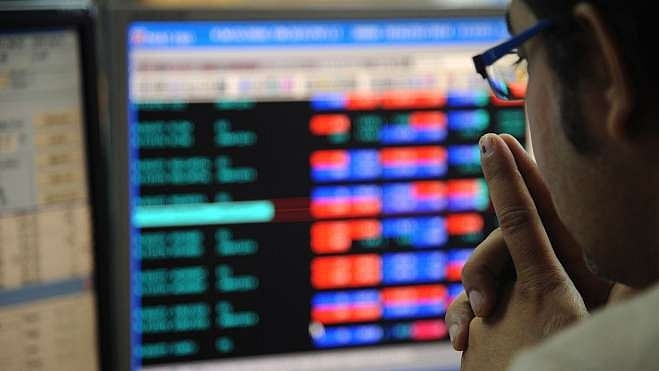Economy
The Sensex Tumble Is No Cause For Panic; Stay Dumb, Stay Invested
- In one line: stay invested in equity. 2018 may be a bad year, but it is not going to be a disaster.
- My expectation is that political trends will decide indices, and the range to expect is 30,000-40,000 on the Sensex.

An investor monitoring the Indian stock market (INDRANIL MUKHERJEE/AFP/Getty Images)
The sharp collapse in share market indices – a near 5 per cent tumble in the Sensex over four trading sessions till Tuesday – will be seen as a direct consequence of the budget’s proposal to tax long-term capital gains (LTCG) and the marginal fiscal slippage in 2017-18.
Ho-hum. This bit of explanation needs to be taken with a bag of salt. Market “experts” tend to explain an index movement by linking it to a proximate event when day-to-day price changes can be driven by many factors, of which liquidity or investor herd mentality may often be the most important. If the LTCG had not been announced, the Dow’s behaviour, Line of Control tensions or even the North Korean crisis could have been blamed for the market tumble.
The real reason why the markets fell so dramatically is simple: once big institutional investors decide which way the market will turn, it does not take very long for them to act on it. The realisation that the market may be running ahead of fundamentals has been there for more than six months now, and when investors get the first excuse for selling, they do so. Mutual funds, which want to beat their tracking indices, tend to follow the herd since staying invested means underperformance. Their goal is not to think contrarian, but to ensure that they do better than their peers. This means losing less than the peers in a bear market, and doing a bit more than them when the market is rising.
Some 20 years ago, when information flows were weak, markets took years to build up or decline. Today, once market mavens decide on what direction the market will take, the indices adjust quickly. It is a self-fulfilling prophecy.
The irony is that the economy is on the brink of a turnaround, and governments (both Centre and states) will be pumping in a lot of money in an election year. So, growth will pick up, and possibly inflation too, especially if minimum support prices are raised significantly and fuel prices are on the upswing. Equity is often the best hedge against inflation. Smart money is thus doing dumb things by exiting equity now.
The question is what should retail investors do now?
First, there is no need for panic. If you are doing SIPs (systematic investment plans), continue doing so. As the market falls, you get more shares per rupee invested.
Second, if you have the courage, invest in shares directly, in addition to mutual funds. The reason is simple: fund managers tend to behave like a herd, and when they buy, the very act of bulk purchases makes shares costlier to acquire (and realisations are lower when they sell). An individual buying an undervalued stock will not rock either the prices or the underlying trend. Blue chip stocks are easier to acquire at reasonable prices for individuals rather than institutions. Investors who make the right stock picks in contrarian bets will make the most money.
Third, with interest rates set to firm up steadily – government bonds are already trending up – bond and debt funds are going to make capital losses. This means equity will continue to outperform other asset classes despite the LTCG.
Fourth, one non-equity asset to look at is tax-free bonds. Remember, there isn’t going to be any new issue in the foreseeable future. This means you can buy what you want from the market at reasonable yields. Example: the NHAI 8.2 per cent 2022 tax-free bond gives a yield to maturity (YTM) of 6.17 per cent, while the NHB 9.01 per cent bond (2034) has a YTM of 6.27 per cent. Ditto for the 8.71 per cent REC bond, maturing in 2028.
Many of these are long-maturity bonds, but at current prices, the pre-tax yields (of over 9 per cent for those in the top tax bracket) are the best for fixed-rate instruments on offer today. Tax-free bonds continue to be better for senior citizens in the higher tax brackets, offering yields better than any other annuity.
In one line: stay invested in equity. 2018 may be a bad year, but it is not going to be a disaster. My expectation is that political trends will decide indices, and the range to expect is 30,000-40,000 on the Sensex.
Introducing ElectionsHQ + 50 Ground Reports Project
The 2024 elections might seem easy to guess, but there are some important questions that shouldn't be missed.
Do freebies still sway voters? Do people prioritise infrastructure when voting? How will Punjab vote?
The answers to these questions provide great insights into where we, as a country, are headed in the years to come.
Swarajya is starting a project with an aim to do 50 solid ground stories and a smart commentary service on WhatsApp, a one-of-a-kind. We'd love your support during this election season.
Click below to contribute.
Latest